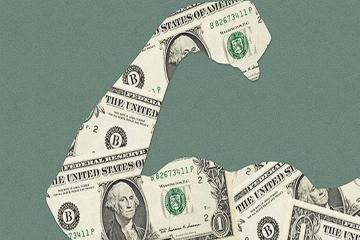The unfolding drama of the U.Sstock market is captivating, as recent developments have sent ripples through the financial landscapeTonight, investors were met with a stark reality as the U.Sstock market opened strong but soon descended into turmoil, marked by a nearly 400-point drop in the Dow Jones Industrial Average and a significant 2.4% decrease in the NASDAQ CompositeMeanwhile, overseas, the European stock markets mirrored this decline, further fueling anxiety among tradersThe situation took a particularly dramatic turn in the Asian markets, with Japan's Nikkei 225 index plummeting more than 3% during after-hours tradingWhat could possibly be driving this wave of sell-offs?
The crux of the issue lies in the latest non-farm payroll data released in the United States, alongside updates on unemployment ratesAugust figures indicated a modest increase of 142,000 jobs—a number that, while showing an uptick from July’s performance, fell alarmingly short of the market's expectations which had pegged job growth at around 165,000. Compounding this was the downward revision of the previous two months’ job gains, now adjusted lower by 86,000 jobs, painting a more severe picture of the job market
Advertisements
For context, a job market showing consistent growth is critical for a healthy economy, fostering consumer spending which drives corporate profits and stock market performance.
Simultaneously, there was a slight dip in the unemployment rate from 4.3% to 4.2%. The household survey revealed a faster increase in employment, with the labor force expanding, holding the labor participation rate steady at 62.7%. However, this seemingly positive news came with caveats; while the unemployment rate for African Americans decreased, the rates for whites remained unchanged, and both Asian and Hispanic unemployment rates saw risesThese mixed signals raise questions about the robustness of the recovery and the inclusivity of economic gains across different demographics.
As analysts sift through the data, the discussions around the Federal Reserve’s potential response to these figures are heating up
Advertisements
The latest employment report has not definitively settled the debate regarding whether the Fed will opt for a more traditional 25 basis points cut or a more significant 50 basis points reductionThe uncertainty is palpable, and it seems more likely than ever that this news will intensify discussions surrounding how aggressively the Fed should act in light of rising risks.
Sonu Varghese, a global macro strategist at Carson Group, expressed concerns regarding the labor market's apparent weakening, suggesting that the Fed may need to intervene to mitigate risks of a further downturnHe stated, “The August jobs numbers show that risks are rising, as the labor market is clearly softening, and the Fed must step in to eliminate tail risksThis report underscores the Fed's resolve for a rate cut in September, but the bigger question is how drastic that cut might be.”
The juxtaposition of Caroline Timiraos' commentary—a so-called “Fed whisperer”—adds another layer of intrigue
Advertisements
According to him, while the overall non-farm figures were not dismal enough to suggest a 50 basis point cut is certain, the revised figures do not convincingly dispel the speculation surrounding more aggressive rate cutsA nuanced dance is unfolding in market expectations concerning the Fed's strategy.
Jeffrey Rosenberg, a senior portfolio manager at BlackRock, raised alarms over the potential implications of a larger rate cutIf the Fed were to cut rates by 50 basis points this month, it could signal deep-seated fears about the economy rather than convey reassurance that decisive steps are being taken to avert a recessionThis line of thought speaks to the crux of the balance that must be struck: central banks must carefully consider the message their monetary policy sends to the markets and consumers alike.
Analysts like Kristine Aquino assert that while the August employment data does not decisively point towards a 50 basis point cut this month, there is a mounting expectation that the Fed will eventually resort to more substantial easing by year-end
- Weak Nonfarm Data Hits US Stocks
- The Rise of Sustainable Investment in Financial Markets
- Analyzing the U.S. Economy in the Third Quarter
- Forex Investing Through Economic Cycles
- Indonesia's Public Spending, Investment Recovering
Current market positioning anticipates a cumulative lowering of interest rates in excess of 111 basis points by December, foreshadowing a shift in monetary policy that many see as inevitable, particularly if the September meeting fails to produce significant action.
Adding to this discourse, Fed Governor Christopher Waller articulated the need for action during a recent speech that followed the release of the employment reportHe remarked, “The data we have received over the last three days suggests that the labor market is continuing to soften, but it is not worseningThis judgment is critical for our upcoming monetary policy decisions.” He went on to express that a series of rate cuts may soon be appropriate and that he remains open-minded regarding the magnitude and pace of such cuts.
Waller's comments have sparked a flurry of market activityHis assertion that he would back “early rate cuts” if deemed necessary, but that the specifics would hinge on upcoming data releases, kept traders on edge

Notably, he emphasized that he does not observe signs that the economy is heading into recession, though he underscored the critical need to initiate a rate cut process during the next meeting.
However, Timiraos pointed out that Waller’s speech lacks concrete references to specific cuts of either 25 or 50 basis points, suggesting a preference for beginning with a 25 basis point reductionHis commentary indicated a strategy that leaves room for flexibility should new data indicate further deteriorationSuch cautious language reflects the delicate balancing act the Fed seeks to maintain—it must navigate between responding to immediate economic indicators and managing long-term expectations.
Cameron Crise, another analyst, weighed in, noting that the market may have overreacted to Waller’s speechHe emphasized the significance of the word “if” in Waller's statements, highlighting that additional data is needed to determine the final magnitude and pace of monetary easing